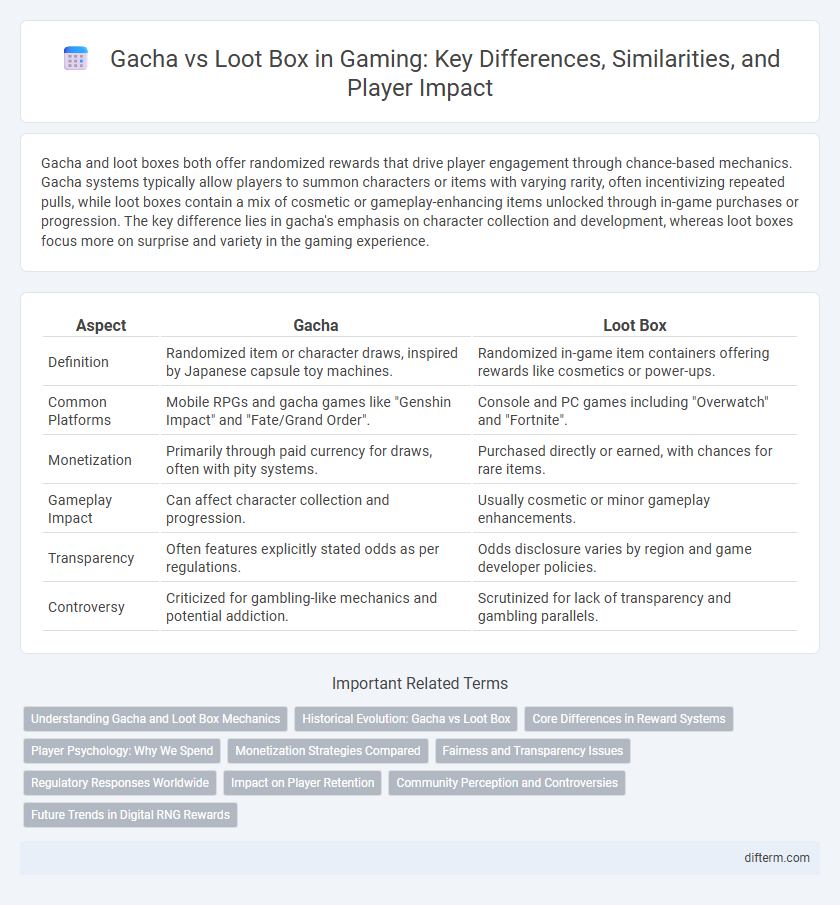Gacha and loot boxes both offer randomized rewards that drive player engagement through chance-based mechanics. Gacha systems typically allow players to summon characters or items with varying rarity, often incentivizing repeated pulls, while loot boxes contain a mix of cosmetic or gameplay-enhancing items unlocked through in-game purchases or progression. The key difference lies in gacha's emphasis on character collection and development, whereas loot boxes focus more on surprise and variety in the gaming experience.
Table of Comparison
| Aspect | Gacha | Loot Box |
|---|---|---|
| Definition | Randomized item or character draws, inspired by Japanese capsule toy machines. | Randomized in-game item containers offering rewards like cosmetics or power-ups. |
| Common Platforms | Mobile RPGs and gacha games like "Genshin Impact" and "Fate/Grand Order". | Console and PC games including "Overwatch" and "Fortnite". |
| Monetization | Primarily through paid currency for draws, often with pity systems. | Purchased directly or earned, with chances for rare items. |
| Gameplay Impact | Can affect character collection and progression. | Usually cosmetic or minor gameplay enhancements. |
| Transparency | Often features explicitly stated odds as per regulations. | Odds disclosure varies by region and game developer policies. |
| Controversy | Criticized for gambling-like mechanics and potential addiction. | Scrutinized for lack of transparency and gambling parallels. |
Understanding Gacha and Loot Box Mechanics
Gacha and loot box mechanics both use randomized reward systems to engage players through chance-based acquisitions, often involving in-game currency or real money. Gacha mechanics typically feature a "draw" system inspired by Japanese capsule-toy vending machines that guarantees certain rarity odds, encouraging repeated attempts to collect characters or items. Loot boxes provide randomized item bundles with variable contents and rarity tiers, frequently integrated into Western games to monetize progression without direct purchase of specific rewards.
Historical Evolution: Gacha vs Loot Box
Gacha mechanics originated from Japanese mobile games in the early 2000s, inspired by traditional capsule-toy vending machines, offering randomized character or item rewards to enhance player collection. Loot boxes emerged later in Western games around the mid-2010s, incorporating similar randomized reward systems but often tied to cosmetic or gameplay advantages, sparking global regulatory scrutiny due to pay-to-win concerns. Both systems have evolved with increasing complexity, integrating monetization strategies that drive player engagement through chance-based acquisition of rare in-game assets.
Core Differences in Reward Systems
Gacha systems utilize a randomized capsule-toy mechanic where players spend in-game currency for chances to obtain specific characters or items, emphasizing collection and progression through rarity tiers. Loot boxes operate by offering randomized bundles of rewards, often including cosmetic upgrades and utility items, with payouts influenced by probability rates but less focused on character acquisition. Both reward systems create excitement through randomness, yet gacha games typically integrate a more strategic element in building teams, while loot boxes prioritize surface-level customization.
Player Psychology: Why We Spend
Gacha and loot box systems tap into player psychology through variable reward mechanisms, exploiting the brain's dopamine response to unpredictability and anticipation. Players are driven by the thrill of chance and the desire to collect rare or exclusive items, which reinforces repeat spending despite uncertain outcomes. This compulsion is amplified by social pressures and in-game status symbols, making these monetization models highly effective in generating ongoing revenue.
Monetization Strategies Compared
Gacha and loot box systems both serve as monetization strategies in gaming by offering randomized rewards that drive player spending. Gacha typically leverages a character or item collection mechanic popularized in mobile games, encouraging continuous pulls for rare units through in-game currency or real money. Loot boxes, often seen in console and PC games, offer randomized content such as cosmetics or gear, relying on player desire for exclusive or rare items to boost revenue through microtransactions.
Fairness and Transparency Issues
Gacha systems often face criticism for lack of transparency, as probability rates can be obscured or manipulated, leading to perceived unfairness in item acquisition. In contrast, loot boxes generally provide clearer odds disclosure, though both models risk encouraging gambling-like behavior through random rewards. Fairness concerns in gacha and loot boxes center on the balance between player investment and reward, impacting player trust and regulatory scrutiny in the gaming industry.
Regulatory Responses Worldwide
Regulatory responses worldwide to gacha and loot box mechanics vary significantly, with countries like Belgium and the Netherlands classifying these systems as gambling and imposing strict bans or regulations. South Korea enforces transparency measures requiring game developers to disclose drop rates, while the United States focuses on consumer protection laws with investigations into potential deceptive practices. Regulatory bodies continue evolving frameworks to address player exploitation and promote fair gaming environments amid growing concerns over monetization tactics.
Impact on Player Retention
Gacha mechanics enhance player retention by offering continuous chances to obtain rare characters or items, fostering long-term engagement through collection and progression. Loot boxes, while providing immediate rewards, often rely on randomness that can lead to player frustration and potential disengagement. Games utilizing gacha systems typically see higher sustained interaction due to the combination of strategic planning and emotional investment in acquiring desired content.
Community Perception and Controversies
Gacha systems and loot boxes both face criticism for encouraging gambling-like behaviors, but communities often view gacha mechanics as more predatory due to their complex, randomized acquisition of characters or items. Loot boxes are frequently scrutinized for their lack of transparency and potential to exploit players through microtransactions, leading to regulatory actions in regions like Belgium and the UK. The controversy around these monetization models centers on ethical concerns, with player backlash driving calls for greater regulation and clearer odds disclosure.
Future Trends in Digital RNG Rewards
Future trends in digital RNG rewards indicate an evolution towards more transparent and player-friendly mechanics in both gacha and loot box systems. Game developers are increasingly integrating blockchain technology and verifiable randomness to enhance fairness and trust in digital item distribution. Emerging models prioritize user choice and ethical monetization, shifting away from traditional pay-to-win dynamics in collectible gaming experiences.
gacha vs loot box Infographic

 difterm.com
difterm.com